Auto logout in seconds.
Continue LogoutAbout six years ago, Walmart launched its Centers of Excellence (COE) program, aiming not only to control mounting health care costs but to improve health outcomes and help sick employees return to work sooner.
Ready-to-present slides: General surgery market trends for 2019
Writing in the Harvard Business Review, Lisa Woods, who leads design and strategy of U.S. benefits at Walmart; Jonathan Slotkin, director of spine surgery at Geisinger Health; and Ruth Coleman, a health executive and nurse, write that Walmart's effort has been a major success—and could prove to be a model for smaller employers.
About Walmart's Centers of Excellence program
Walmart's COE program has its roots in a now-famous speech that Walmart founder Sam Walton delivered nearly 30 years ago, the authors write.
"These people are skinnin' us alive," Walton said, referring to health care providers. "Not just here in Bentonville but everywhere else, too. … They're charging us five and six times what they ought to charge us. … So we need to work on a program where we've got hospitals and doctors … saving our customers money and our employees money. We haven't even started to do that. And if we don't get it done this year, I'm gonna get real upset. I mean real upset."
In the decades since then, Walmart has experimented with a variety of ways to rein in health care costs—perhaps most ambitiously with its COE program, which launched in 2013.
Under the program, Walmart covers the full cost of travel and treatment for employees seeking certain cancer evaluations, organ transplants, and common surgeries such as heart, hip, knee replacement, and spinal procedures.
The catch? Employees must agree to seek care at a designated hospital. Walmart, which self-insures its employees, then reimburses the hospitals via bundled payment agreements negotiated directly with the providers.
Why the COE program is a win-win
Overall, the COE program has been a major success, according to Woods, Slotkin, and Coleman. To demonstrate how the program works, they shared the story of "Bill," a Walmart employee whose name was changed for privacy reasons.
Bill had been suffering from mild neck pain for some time and eventually developed a tremor in his hands. A local surgeon recommended that Bill receive spinal surgery, so Walmart paid for Bill and his wife to fly to Geisinger Medical Center to get a second opinion. There, the doctors noticed a shuffle in his step and diagnosed him with Parkinson's disease—which could not be treated surgically.
Bill was able to avoid an unnecessary painful and expensive surgery, while Walmart saved about $30,000 that it would have paid for the surgery. Further, after Bill began treatment for his Parkinson's disease, his symptoms improved, and he was able to return to work with renewed energy. For both Walmart and Bill, the situation was a win-win.
Woods and colleagues write that these situations are common in the COE program. So far, more than 5,000 Walmart employees have participated in the program, and more than 95% said they were "satisfied" or "very satisfied" with the care and overall experience. One employee in particular said it was "the best medical experience of my life. This is the most important benefit of working at Walmart."
Woods and colleagues cite data that show nearly half of the Walmart employees who had spinal surgery or a medical evaluation without surgery between 2015 and 2018 did so at a COE site. Of those who did have a spinal surgery, the patients who did so at a COE site spent 14% less time in the hospital and faced a 95% lower risk of readmission than those treated elsewhere.
As for the cost to Walmart, surgery at a COE site costs about 8% more than elsewhere, but the benefits have outweighed that cost, Woods and colleagues write, as employees are able to return to work sooner and are less likely to be readmitted to the hospital.
And the benefits aren't limited to spinal surgery. Among Walmart employees who had joint replacement surgery between 2015 and 2018, the patients who had the surgery at a COE site spent 32% less time in the hospital and were 70% less likely to be readmitted than those who had the surgery elsewhere. Further, the cost per case of joint replacement surgery was about 15% less at COE sites than at non-COE sites.
What does Walmart's experience mean for other companies?
Woods, Slotkin, and Coleman write that Walmart is one of several "innovative companies, including Lowe's, McKesson, GE, and Boeing, [that] are disrupting how employers pay for care by taking insurers out of the equation and contracting directly with leading health systems."
According to a Willis Towers Watson survey, 22% of employers said they "either planned to contract directly [with providers] or would consider doing so by 2019," the authors write, up from about 6% of employers that had such relationships in 2017.
While Walmart has relied on bundled payments and, in other instances, an ACO-like model, Woods, Slotkin, and Coleman write, "[t]hese relationships can take many forms." They may, for instance, use so-called person-year arrangements that set a payment amount per enrollee over a defined period.
Woods, Slotkin, and Coleman write that, by sharing Walmart's lessons and successes, they hope to make similar programs available to smaller employers—which may band together into purchaser coalitions to increase their market power.
In an interview with CNBC, Woods said, "This has been a journey we've been on for several years," adding, "We're committed to sharing what we learn" (Woods et. al., Harvard Business Review, March 2019; Farr, CNBC, 3/14).
Ready-to-present slides: General surgery market trends for 2019
Want the latest information for your next surgical services meeting? We updated our most popular slides on general surgery with the latest market trends for 2019. This ready-to-use presentation covers everything from demand drivers and financial considerations to new care management priorities and technology innovations.
Use these slides to frame your next strategy meeting and build a strong foundation for your presentation.
Don't miss out on the latest Advisory Board insights
Create your free account to access 1 resource, including the latest research and webinars.
Want access without creating an account?
You have 1 free members-only resource remaining this month.
1 free members-only resources remaining
1 free members-only resources remaining
You've reached your limit of free insights
Become a member to access all of Advisory Board's resources, events, and experts
Never miss out on the latest innovative health care content tailored to you.
Benefits include:
You've reached your limit of free insights
Become a member to access all of Advisory Board's resources, events, and experts
Never miss out on the latest innovative health care content tailored to you.
Benefits include:
This content is available through your Curated Research partnership with Advisory Board. Click on ‘view this resource’ to read the full piece
Email ask@advisory.com to learn more
Click on ‘Become a Member’ to learn about the benefits of a Full-Access partnership with Advisory Board
Never miss out on the latest innovative health care content tailored to you.
Benefits Include:
This is for members only. Learn more.
Click on ‘Become a Member’ to learn about the benefits of a Full-Access partnership with Advisory Board
Never miss out on the latest innovative health care content tailored to you.



